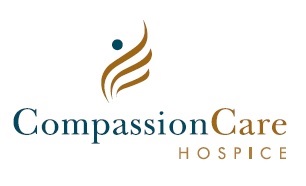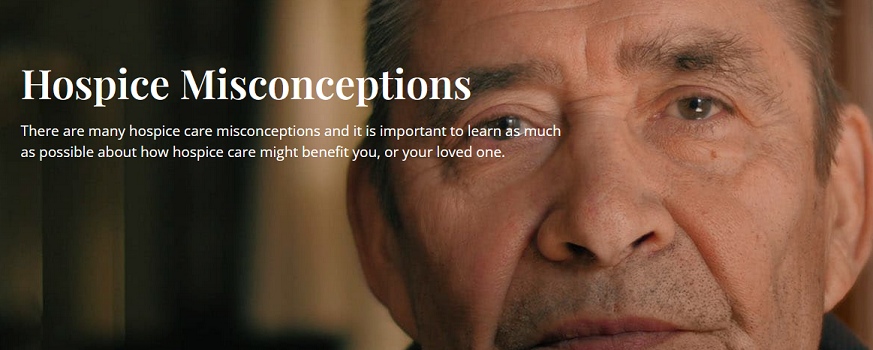
Education provided by CompassionCare Hospice, but is applicable to all Medicare certified hospices
The concept of hospice is new to many people, and there are many misconceptions about it. Hospice is an alternative to traditional medicine that is centered on palliative care; the management of a patient’s pain and symptoms so that every moment can be as comfortable and rewarding as possible. Hospice care is an affirmation of life that focuses on comfortable, pain-free care when a loved one is faced with a terminal illness. Hospice is comfort care intended to give those with a terminal diagnosis the best possible quality of life. The goal of hospice care is to promote a life free of pain and discomfort for the patient, as well as support their loved ones.
For many of us, some of our biggest fears include being alone at the end of our life. Being alone in unfamiliar surroundings, away from family and loved ones, hooked up to machines and in pain. But there is another option for end-of-life care that is available to all of us. An option that allows us to remain at home, surrounded by those we love, with our pain and symptoms well managed, so that we can fully enjoy the time we have left. An option that provides compassion, respect, and dignity to each individual, known as In-Home Hospice Care.
In most common home hospice situations, the primary caregiver to the patient is a family member who attends to daily needs. We understand that being a caregiver can be a daunting task, and at times, you may feel overwhelmed. That is why a vital part of the care we provide is centered around supporting everyone involved with a patient, including family, loved ones and caregivers.
By utilizing an integrated interdisciplinary team approach, hospice provides a whole team, for the whole person, for the whole family. Hospice care may be provided at patient’s home, a family member’s home, in a skilled facility, an assisted living, or a local hospital (must qualify for inpatient level of care). A team-oriented approach to hospice care includes medical, social, emotional and spiritual support to guide you and your family through this difficult time. An experienced care team will tailor and deliver an individually-focused care plan to meet your needs and preferences. Many different forms of support are offered under in-home hospice care. Nurses, hospice aides/certified nursing assistants (CNA’s) and Physicians attend and oversee a patient’s care on a regular basis. Social workers and counseling services are available for both the patient and family/caregiver, and are an important part of hospice team. Chaplains are available for spiritual visits and accommodations can be made for volunteer assistance, as well. Hospice staff are available 24 hours a day to address the needs of the patients and their family by phone and in-person visits should be expected for any change of condition or emergencies.
Sometimes during a crisis, medical interventions happen before we even have a chance to understand them. With hospice care services, we can help families understand, prepare for, and support one another throughout the hospice journey. For most of us, our families are our biggest source of support. With the guidance of the hospice team, we can assure that families and loved ones will have all the tools and resources needed to give the best care possible.
Hospice care can help family members come together. Family meetings, often led by a hospice social worker or nurse, can help you talk about your feelings, cope with the issues, and help guide the family in making the best choices for everyone. Hospice also supports you in saying goodbye to your loved one, when the time comes. Religious or spiritual traditions and personal faith can play an important role in a patient’s physical and emotional well-being, as well as the family’s own comfort too. Chaplain services are available to meet these often complex needs. Hospice care even includes the help of volunteers that provide extra relief to families. Volunteers may run errands, provide companionship to the patient, do light housekeeping or sit with your loved one, so you can attend to personal matters.


Now, more than ever, there is a sense of urgency in our country to start discussions about how we would want to be treated, if we were faced with a life-limiting illness. Discussing end of life care options, preparing advance directives, and letting our loved ones know our wishes, are all important topics. Hospice care can provide innumerable benefits to those with life-limiting illnesses, and their loved ones. But there are many hospice care misconceptions and it is important to learn as much as possible about how hospice care might benefit you, or your loved one. We have many choices about the services we receive toward the end of life, and hospice care is an important one to consider.
Unfortunately, there are many misconceptions when it comes to Hospice care. Below, we will address some of the common hospice misconceptions we frequently hear:
We all want more time. That’s only human. But while advanced medical care can do wonders for people with life-limiting illnesses, it can also become exhausting and counter-productive. Still, we keep trying, because to do otherwise feels like giving up. At some point, a decision may have to be made – not about ceasing all care, but about weighing the benefits of a certain course of treatment against the burdens of that treatment. What matters most may not be more time, but the ability to more fully enjoy the time we have with those we love. Hospice care provides hope by giving patients a chance to live their lives without being debilitated by pain and exhausted by unnecessary medical treatments and hospital visits. Hospice care also provides caregivers the support they need physically, emotionally and spiritually. The hospice team will make sure that the caregiver is fully informed and well prepared to care for their loved one to the best of their ability.
Those with life-limiting illnesses may struggle to do some of the things they once did. But hospice is founded on the idea that, with proper pain and symptom management, patients can enjoy a much better quality of life. Hospice patients are encouraged to do those things they most enjoy and desire to do, to fulfill their “bucket list”. Things like spending time with friends, going out to dinner and shows, even camping and traveling. There are no age or disease restrictions to receive hospice services. Anyone with a life-limiting illness may qualify to receive support. Hospice may be appropriate for those with any progressive condition such as: cancer, Alzheimer’s/dementia, stroke, pulmonary diseases, or liver disease just to name a few.
This misconception arises from Medicare hospice guidelines, which state that a hospice patient must be certified as having six months or less to live if the disease progresses as expected and takes its natural course. However, we know that with hospice support and all the care and services that are provided, people may live well beyond this expectation. Patients can continue to receive hospice services indefinitely, as long as they continue to meet the medical criteria as outlined by Medicare. Patients are assessed regularly during each certification period (which is twice in the first 180 days of service, and then every 60 days thereafter). As long as the patient continues to meet Medicare criteria, they can continue to receive hospice support, indefinitely.
This misconceptions is also untrue; any medications that are medically necessary are continued, as well as medications for pain or other distressing symptoms. While hospice care focuses on palliative, or comfort care, it is holistic in nature. Meaning, we are not only concerned with a patients’ medical diagnosis that led them to hospice, but everything that is going on with that patient. A patient may start hospice care for terminal cancer, but if they also have high blood pressure, this needs to be treated, to keep them comfortable. Our primary goal with hospice care is to keep the patient as comfortable as possible, promoting the highest quality of life. This allows our patients and their loved ones to focus on the things that are most important to them.
Hospice is a choice, and patients who choose hospice care can always choose to seek aggressive treatments again, if desired. A patient may qualify and choose hospice support, and then improve or decide to seek aggressive treatment. They can easily revoke their hospice benefit, and resume tradition care at any time. Hospice is also not just a one-time benefit. If someone qualifies for hospice support but then decides they no longer wish to receive it, or no longer meet criteria, they can also decide to resume hospice support at a later date, as long as they meet criteria. There is no limit to the number of times that a patient can receive Hospice care in their lifetime.
Hospice isn’t a place, it’s a concept of care, focused on palliative or comfort care and managing symptoms, aimed at improving quality of life. Hospice is a service, rather than a place you go, and is provided wherever a person calls home. This may include private residences, assisted living facilities, skilled nursing facility, or group home settings.
Hospice nurses and other health care professionals provide support and are available 24 hours per day. Routine care at home is usually provided by a family member, or caregiver, who sees to the patient’s daily needs, including help with taking medications. The hospice team which includes physicians, nurses, certified nursing assistants and social workers, make regular visits to provide skilled care. If a patient experiences a crisis, such as unmanaged pain, respiratory distress, or unmanaged anxiety, Medicare has options for higher levels of care. These include Continuous Care at home, or General Inpatient Care, until the crisis resolves. Both of these levels of care are intended for short term, acute crisis management. Once the crisis is resolved, the patient returns to routine care wherever they call home. To learn more about the hospice levels of care, please see Four Levels of Hospice Care, below.
We believe this misconception arises from the fact that hospice is palliative in nature, focused on managing pain and other distressing symptoms. However, each patient is unique, and our goal is to promote the highest quality of life by ensuring that our patients are as comfortable as possible- without being overmedicated. This allows them to be comfortable, and focus on those things that are most important to them. Hospice staff are experts in pain and symptom management, and our patients are directly involved in their plan of care. This includes addressing pain and symptom management with their hospice physician and nurse. Treatments are chosen based on the patient’s wishes, values and beliefs. The care plan is ever-evolving, and can change as the patient’s condition changes.
While we do see patients with end stage cancer, this is only one of many diagnosis that we encounter. Medicare guidelines actually say that there are no disease restrictions in determining if someone can receive hospice support. Rather, anyone who has been diagnosed by a physician with any life-limiting (terminal) illness, may qualify for hospice care. While this includes patients with cancer, some of the other diagnosis we see are end stage diseases such as lung diseases (COPD, emphysema), heart disease, kidney disease, Parkinson’s, ALS, Alzheimer’s and other Dementia’s. We also see patients that have multiple chronic illnesses, that when looked at together, make their health fragile and shorten their life expectancy. Medicare is concerned with the patients prognosis- what do we think the likely outcome of the disease will be, if it continues to run its’ course as expected.